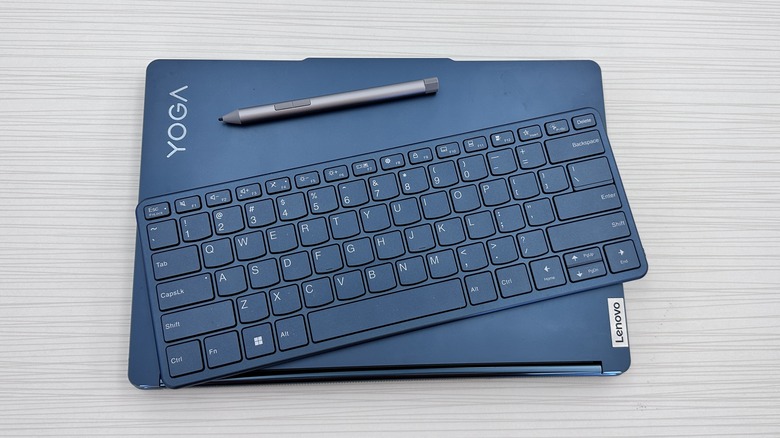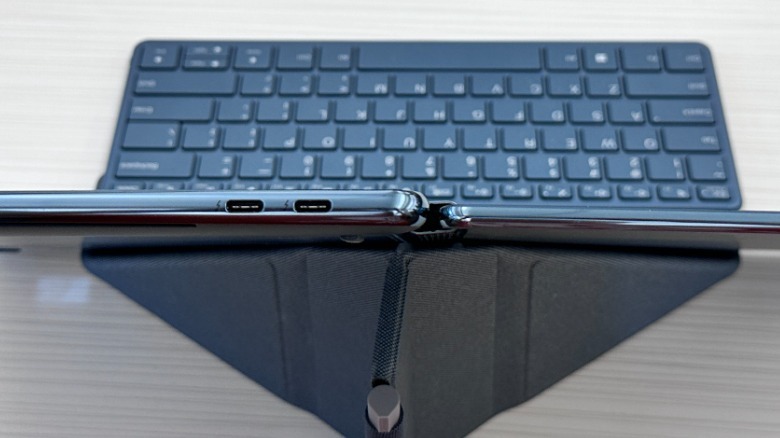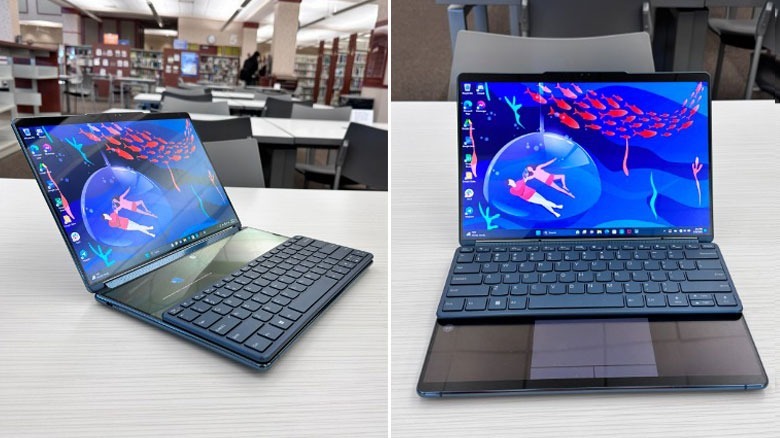Lenovo Yoga Book 9i Review: The Best Dual Screen Laptop Yet
- Versatile dual-screen layout
- Thoughtful implementation
- Solid software
- Great speakers
- Useful keyboard
- Battery Life is not great
- Expensive
We may receive a commission on purchases made from links.
Those of you who live on the edges of society have come to expect a certain amount of compromise when using a personal smart device that doesn't conform to the "normal" use case. Maybe you have an extremely rugged and durable phone that you can drop-kick into a pit of muck if you wanted to. Maybe you have a car that can drive itself to your destination mostly by itself, as long as you're paying attention.
Each of those has a major compromise that you're just willing to accept because you fit into that niche. Your rugged phone usually won't be very good by any standard other than its ability to survive a construction site. Your self-driving car may suddenly decide to get confused between a truck and the sky and force you to take the controls. In almost every case, there is a give and take, a "wow" but also a "Yeah but..." It would be perfectly normal to assume that there is a "Yeah, but" in the Lenovo Yoga Book 9i, and there most assuredly are a few.
But it's also not hard to imagine that the benefits of this device far outweigh the compromises. The compromises involved are either minor or painfully obvious from the jump. Compared to the value add of carrying around a dual-screened laptop, they're like buying a new car with the change you find in your couch.
This review was conducted using a review sample provided by Lenovo.
Just like any other laptop -- to a point
One of the first things you'll notice about the Lenovo Yoga Book 9i is that when closed, it looks like any other laptop. Around the sides, of the laptop you're treated to minimal I/O including 3 Thunderbolt 4 USB-C ports, a power button, and what is quickly becoming a Lenovo trademark, the physical camera switch. The hinge also contains rotating speakers for the laptop, and the bottom half of the laptop is noticeably thicker than the top half.
But when you open the device, you're treated to two large 13.3-inch 2.8K OLED screens. These screens can be used in a variety of ways, which is why this laptop is extremely useful on the go, especially for those with a multi-screen workflow. The postures will be saved for a later section, but suffice it to say, this laptop earns the Yoga name.
As for the rest of the internals, you have a 13th-Generation Intel Core i7-1355U processor, 16 GB of LPDDR5x RAM, and 52 GB of storage. Modders will want to shy away as there are no external screws, so you won't be adding your own RAM — choose your specifications wisely when ordering. The most obvious way that this laptop differs from its single-screen compatriots is the fact that the keyboard comes as a separate unit.
Physical Keyboard and stand
The keyboard on the Lenovo Yoga Book 9i is a separate piece that is extremely thin and comfortable to use. If you like longer keystrokes on your keyboard, you will abhor this one. Even if you prefer chicklet-style keyboards you might want a bit more travel than this keyboard offers. It's easy to get used to, but after a while, it feels like you might as well be typing on the screen (which by the way, is an option we'll get to shortly).
The keyboard has several magnetic attachments which are used in a variety of ways. First, it magnetically attaches to its case, so that case can serve as a stand for the screen if you want to use both. If not, you can remove the keyboard from the stand and magnetically attach the keyboard to the lower screen of the Yoga Book in one of two ways.
If you attach the keyboard so it covers the lower half of the screen, the upper half becomes a home for widgets that can show you things like your Outlook Mail or your Bing home screen. Those are the only two widgets so far, but more are expected to come in the coming months. It should be noted though that these widgets are purpose-built for this laptop by Microsoft, so you can expect the focus of those widgets to surround Microsoft services.
If you push the keyboard to cover the upper half of the lower screen, the bottom section becomes a trackpad with buttons, so you can navigate the computer with a mouse pointer.
Keyboard and mouse tricks
If you don't want to tote along a separate keyboard, you can use the laptop in a typical laptop "posture" (to borrow a term from the Microsoft Surface Duo). When you have the laptop in laptop orientation, you can tap on the lower screen with eight fingers and a software keyboard appears. Just like the physical keyboard, you can use your eight fingers to move the keyboard to the top or bottom of the lower screen to get the same widgets or mouse/trackpad.
This is really the most "fun" feature the Yoga Book has and the easiest to demonstrate at parties to impress your friends. But this is not a gimmick or party trick so much as it's a necessary feature to make this laptop useable.
When you open the keyboard case (which also holds the stylus by the way) and fold it around, it becomes a stand to use the laptop in dual screen mode, either side-by-side or stacked with one screen on top of the other. This is where the Yoga Book truly shines. Having this much screen real estate to play with is game-changing in a laptop, and the fact that it's all built-in with everything you need included in the box is just the first part of how great this is.
Smart software designed for this laptop
As you might imagine there's quite a bit of software at work here to make this laptop really functional, and Lenovo has put a lot of thought into it. The keyboard trick previously described is the big one, the one that was needed to make this a functional laptop regardless of the circumstances. But Lenovo went further.
Hands down the most useful secondary trick is the three-finger tap to open a virtual mousepad. In the 10-plus years that Microsoft has spent trying to make Windows touch-optimized, it still has not figured out how to make a finger work like a mouse. As such, a number of apps that would seemingly be a great fit for a touch screen don't behave well at all. Fortunately, the virtual mouse pad is a nice workaround for those apps, since that functions like a mouse, and not like a finger. One weird limitation is that the three-finger tap only works on the lower half of the laptop, not the upper half, and that limitation continues when the screens are displayed side-by-side. You'll have to remember that only the thick side can have the virtual trackpad — and it's not entirely clear why.
Other software tricks include the "flick" to move windows between screens. If you don't want to flick the windows, you can also move them between windows by dragging your finger across from one screen to the other — though that really only effectively works from the top screen to the bottom. You can also use the aforementioned virtual trackpad to move windows around. There's also a UI icon with an arrow that pops up when you're holding a window, and if you drag the window onto that arrow, the window jumps as expected.
Performance and battery
As for performance, the Yoga Book 9i is a very capable basic computer for those who work primarily in browser windows, and chatting tools like Slack. When you really start to push this laptop such as gaming or heavy graphics/video work, you will notice some stutters and lag. While 16 GB of RAM is pretty good by today's standards, the integrated graphics generally won't cut the mustard for anything beyond simple image manipulation. Add that to an 11,539 Geekbench 6 score, and you've got a computer that can do moderate lifting, but won't be an amazing gaming PC. That's a limitation that's not uncommon to laptops, but considering the price tag this laptop demands, that's also not ideal.
As for the battery, that is the biggest and most obvious strike against this laptop simply because it has two screens it needs to power. Battery life is generally ok as long as you plan for it. You can be off the plug from 8:00 am until noon, and you'll be down to around 40%. Plug in (and fold up the laptop) for an hour-long lunch and you'll be able to finish out your day easily on what's left. Just don't forget to plug it in overnight too.
That should not be surprising — battery life was destined to become the hardest thing that Lenovo would have to overcome with a device such as this. The 68W charging brick that comes with the laptop is adequate to fast charge the machine during that lunch break, but it's on the bigger side, so it's not terribly easy to pack in a shoulder bag.
Accessories and limitations
The Lenovo Yoga Book comes with a wireless mouse you can use to complement the keyboard if the software mouse isn't your style. It's a pretty basic two-button-with-a-scroll-wheel mouse that works well enough, but it's honestly just one more thing you have to carry with you. You'll find the touch screen/virtual touchpad works just as well if you're away from a desk where you can store it.
The software is not perfect. When you have a window in the lower half of the screen and you attach the keyboard or bring up the virtual keyboard, that window on the bottom screen gets buried beneath that UI and is essentially not usable until you remove the keyboard. Speaking of the virtual keyboard, the eight-finger gesture makes a lot of sense, except when you're standing and holding the laptop. Then, there's no way to open it. An alternate, one-handed gesture should be in place for that admittedly niche case.
Also, the widgets-by-Microsoft are fine, but Lenovo is missing an opportunity here to use the top half of the bottom screen as just more desktop. You can do that by turning off the widget bar, but when you do, there are no boundaries on that lower half that prevent a window from spilling beneath the keyboard. Plus, if you remove the keyboard and reattach it, the widget bar opens itself, once again hiding your window. Instead, Lenovo should allow you to drop scaled-down windows into that widget bar so you can open YouTube Music, Spotify, or perhaps a non-Microsoft email or calendar window.
Worth every penny
This laptop is incredibly useful for a wide range of use cases. You can take this laptop on a train and write a review on it, or you can bust this out on your kitchen table and have two screens to work with. If you're a coder or you're doing research, use the screens side-by-side. If you want to have your communications on the second level and your work product on the first, use the laptop as a stacked computer. If you have back problems, move your work product to the top screen to put it at eye level. This is a very versatile machine.
At $2,000 for the base model, it's expensive but not unreasonable. When you only consider the specifications that this laptop comes with, that's a lot of money. But when you consider the versatility of the machine, and the fact that it's compact, and doesn't require any additional attachments or cables to get that second screen, and it's a compelling package. Yes, that comes at a premium, but it's a premium that brings tremendous value and a cool trick that will make you the envy of the coffee shop.
Lenovo Yoga Book 9i Final Verdict
Overall, this is an amazing machine to work with, especially if you have a multi-window workflow. From editing documents to research to task management, the utility that a second screen adds is almost priceless. The fact that you can use this as a normal laptop as well is just icing on the cake. But the overall package here is extraordinary. Lenovo didn't just slap together a couple of screens and push it out to the market. It put a lot of thought into how the laptop would need to be used, whether you're sitting in a cramped press room or airplane seat, or you have the ability to spread out at a coffee shop. It's the level of polish here that's significant.
One of the hallmarks of the Yoga Book series is the flexibility to work where you need it — see what Lenovo did there? But for maybe the first time, Lenovo has taken that flexibility concept and turned it up to 11. Not only can you get the traditional 2-in-1 configurations, but you can go even further with the included keyboard and keyboard case that will easily fit itself into anyone's workflow. It's this complete package that will make it hard to go back to working on a "normal" laptop.
This device is scheduled for release in June of 2023. It'll be listed by Lenovo's online store and Best Buy when it's in stock for an expected starting price of around $2000.












